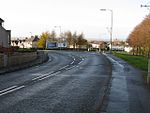Monklands (district)

Monklands (Bad nam Manach in Scottish Gaelic) was, between 1975 and 1996, one of nineteen local government districts in the Strathclyde region of Scotland.The district was formed by the Local Government (Scotland) Act 1973 from: The burghs of Coatbridge and Airdrie Most of the Lanarkshire landward Ninth District The electoral district of Shottskirk from the Lanarkshire landward Seventh DistrictThe district administrative headquarters were based at Coatbridge Municipal Buildings in Coatbridge, the largest conurbation. Apart from the two burghs, the area included the following settlements: Bargeddie Calderbank Caldercruix Chapelhall Glenboig Glenmavis Greengairs Plains SalsburghThe district was abolished in 1996 by the Local Government etc. (Scotland) Act 1994. The area of the district was combined with those of Cumbernauld and Kilsyth and Motherwell districts and part of Strathkelvin to become North Lanarkshire unitary council area. The name of "Monklands" originated in the grant of lands in the area to the monks of the Cistercian Abbey of Newbattle, Midlothian in 1162. From the seventeenth century the area was formed into the two parishes of New Monkland and Old Monkland.Although the council is gone, the area is often informally referred to as Monklands. Indeed, the local hospital (in Airdrie) used to be called Monklands District General Hospital, and football matches between the two senior teams in the area, Airdrieonians and Albion Rovers, are often referred to as Monklands Derbies.
Excerpt from the Wikipedia article Monklands (district) (License: CC BY-SA 3.0, Authors, Images).Monklands (district)
Carlisle Road,
Geographical coordinates (GPS) Address Nearby Places Show on map
Geographical coordinates (GPS)
| Latitude | Longitude |
|---|---|
| N 55.829 ° | E -3.922 ° |
Address
Carlisle Road
Carlisle Road
ML1 5LT , Newhouse
Scotland, United Kingdom
Open on Google Maps








